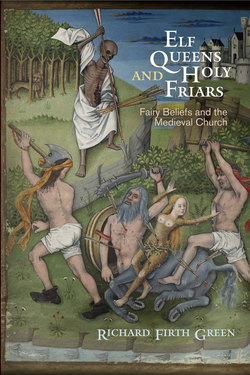Elf Queens and Holy Friars

Реклама. ООО «ЛитРес», ИНН: 7719571260.
Оглавление
Richard Firth Green. Elf Queens and Holy Friars
Отрывок из книги
Elf Queens and Holy Friars
Ruth Mazo Karras, Series Editor
.....
Clearly fairy beliefs occupied an anomalous status in the official culture of the later Middle Ages. While scholastic theology may have regarded them as demonic, at the pastoral level they were far too deeply entrenched in the vernacular consciousness to be easily extirpated, and an uneasy truce was maintained. Is it, then, possible to delve further into this vernacular consciousness, to discover any direct evidence for the nature and extent of these beliefs?
Jacques Le Goff has written of “the near impossibility of transporting to the past the methods of observation, investigation, and enumeration, applied by sociologists to contemporary societies,”74 and while there is no reason to suppose that popular belief was any more homogeneous in the Middle Ages than it is now (“ther ben many folk that beleeven because it happeneth so often tyme to fallen after here fantasyes,” writes Sir John Mandeville, “and also there ben men ynowe that han no beleve in hem”),75 its nuances are far more difficult to penetrate. Certainly the nearest thing to a statistical sample we possess—the thirty-four people from Domrémy and the surrounding area who were questioned about a fairy tree (“arbor Fatalium, gallice des fees”) in 1452 as part of the process to nullify Joan of Arc’s condemnation twenty years earlier—yields very modest results, at least statistically.76 In 1431 Joan herself had informed her inquisitors that she had never seen fairies at the tree “as far as she knew” [dixit quod nunquam vidit predictas Fatales apud arborem, quod ipsa sciat]—though she did concede that one of her godmothers claimed to have seen them—and she stoutly denied that the gatherings at the fairy tree that she had attended as a young girl were anything other than innocent springtime picnics.77 Of the thirty-four later witnesses questioned about the arbre des dames, ten knew, or affected to know, nothing at all about it (though hardly any of these were from the immediate area of Domrémy) and only nine admitted to having heard that in the old days fairies were to be seen there; no one admitted to believing in fairies personally, though a forty-four-year-old laborer named Michel Buin did say that he did not know where they had gone, because they no longer visited the tree. The Domrémy villagers were under no particular threat from the commission (indeed the commissioners were eager for reassurance that Joan’s youthful activities were entirely innocent), yet even so their responses were warily noncommittal. In view of the fact that Bernard Gui’s famous inquisitors’ manual requires further investigation of anyone who believes in “fairy women, whom they call the good things” [de fatis mulieribus quas vocant bonas res],78 perhaps we can hardly blame them.
.....